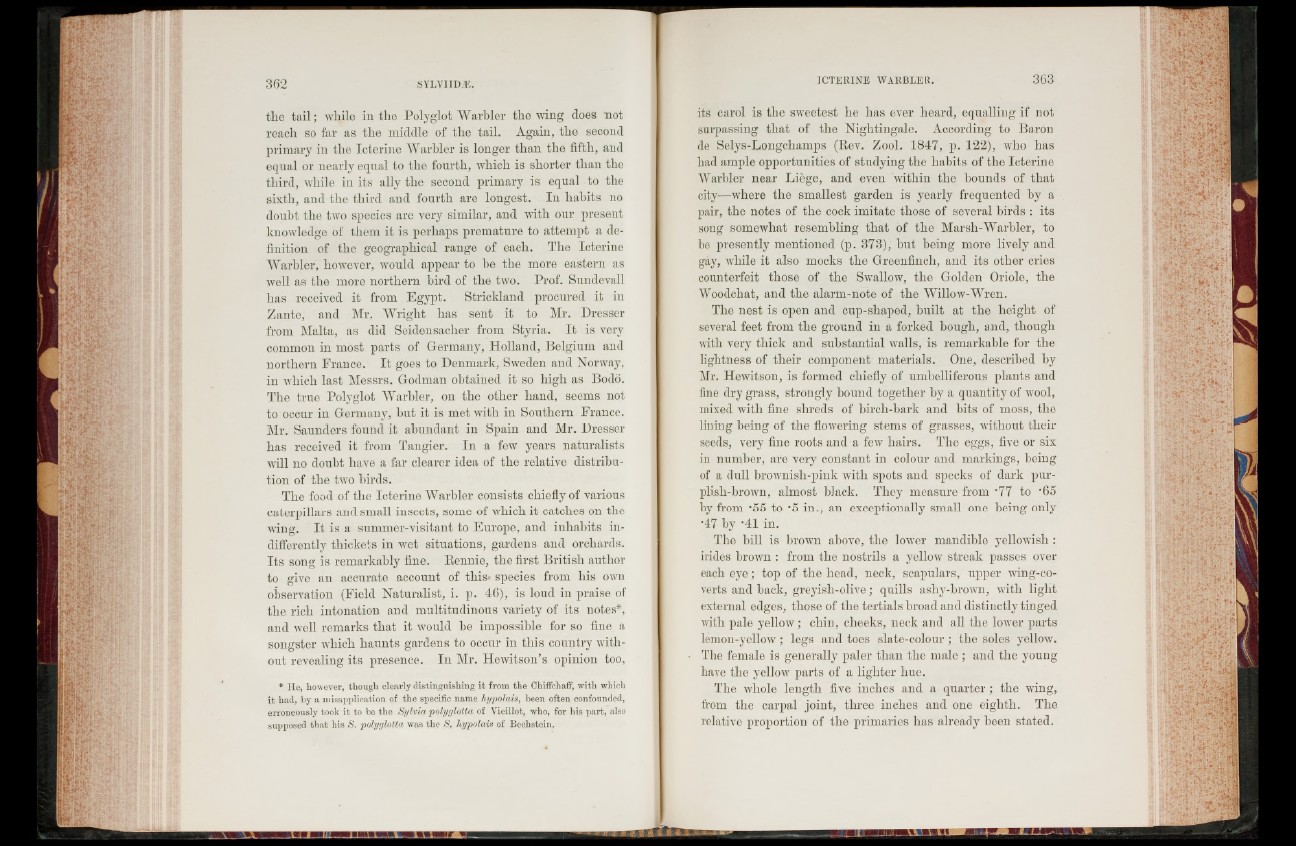
the tail; while in the Polyglot Warbler the wing does not
reach so far as the middle of the tail. Again, the second
primary in the Icterine Warbler is longer than the fifth, and
equal or nearly equal to the fourth, which is shorter than the
third, while in its ally the second primary is equal to the
sixth, and the third and fourth are longest. In habits no
doubt the two species are very similar, and with our present
knowledge of them it is perhaps premature to attempt a definition
of the geographical range of each. The Icterine
Warbler, however, would appear to be the more eastern as
well as the more northern bird of the two. Prof. Sundevall
has received it from Egypt. Strickland procured it in
Zante, and Mr. Wright has sent it to Mr. Dresser
from Malta, as did Seidensacher from Styria. I t is very
common in most parts of Germany, Holland, Belgium and
northern France. I t goes to Denmark, Sweden and Norway,
in which last Messrs. Godman obtained it so high as Bodo.
The true Polyglot Warbler, on the other hand, seems not
to occur in Germany, but it is met with in Southern France.
Mr. Saunders found it abundant in Spain and Mr. Dresser
has received it from Tangier. In a few years naturalists
will no doubt have a far clearer idea of the relative distribution
of the two birds.
The food of the Icterine Warbler consists chiefly of various
caterpillars and small insects, some of which it catches on the
wing. I t is a summer-visitant to Europe, and inhabits indifferently
thickets in wet situations, gardens and orchards.
Its song is remarkably fine. Bennie, the first British author
to give an accurate account of this< species from his own
observation (Field Naturalist, i. p. 46), is loud in praise of
the rich intonation and multitudinous variety of its notes*,
and well remarks that it would be impossible for so fine a
songster which haunts gardens to occur in this country without
revealing its presence. In Mr. Hewitson’s opinion too,
* He, however, though clearly distinguishing it from the Chiffchaff, with which
it had, by a misapplication of the specific name hypolais, been often confounded,
erroneously took it to be the Sylvia polyglotta of Vieillot, who, for his part, also
supposed that his S. polyglotta was the S. liypolais of Bechstein.
its carol is the sweetest he has ever heard, equalling if not
surpassing that of the Nightingale. According to Baron
de Selys-Longcliamps (Bev. Zool. 1847, p. 122), who has
had ample opportunities of studying the habits of the Icterine
Warbler near Liège, and even within the bounds of that
city—where the smallest garden is yearly frequented by a
pair, the notes of the cock imitate those of several birds : its
song somewhat resembling that of the Marsh-Warbler, to
be presently mentioned (p. 373), but being more lively and
gay, while it also mocks the Greenfinch, and its other cries
counterfeit those of the Swallow, the Golden Oriole, the
Woodcliat, and the alarm-note of the Willow-Wren.
The nest is open and cup-shaped, built at the height of
several feet from the ground in a forked bough, and, though
with very thick and substantial avails, is remarkable for the
lightness of their component materials. One, described by
Mr. Hewitson, is formed chiefly of umbelliferous plants and
fine dry grass, strongly bound together by a quantity of wool,
mixed with fine shreds of birch-bark and bits of moss, the
lining being of the flowering stems of grasses, without their
seeds, very fine roots and a few hairs. The eggs, five or six
in number, are very constant in colour and markings, being
of a dull brownish-pink with spots and specks of dark purplish
brown, almost black. They measure from "77 to ’65
by from '55 to m5 in., an exceptionally small one being only
•47 by -41 in.
The bill is brown above, the lower mandible j’ellowisli :
irides brown : from the nostrils a yellow streak passes over
each eye ; top of the head, neck, scapulars, upper wing-co-
verts and back, greyish-olive ; quills ashy-brown, with light
external edges, those of the tertials broad and distinctly tinged
with pale yellow ; chin, cheeks, neck and all the lower parts
lemon-yellow ; legs and toes slate-colour ; the soles yellow.
The female is generally paler than the male ; and the young
have the yellow parts of a lighter hue.
The whole length five inches and a quarter ; the wing,
from the carpal joint, three inches and one eighth. The
relative proportion of the primaries has already been stated.